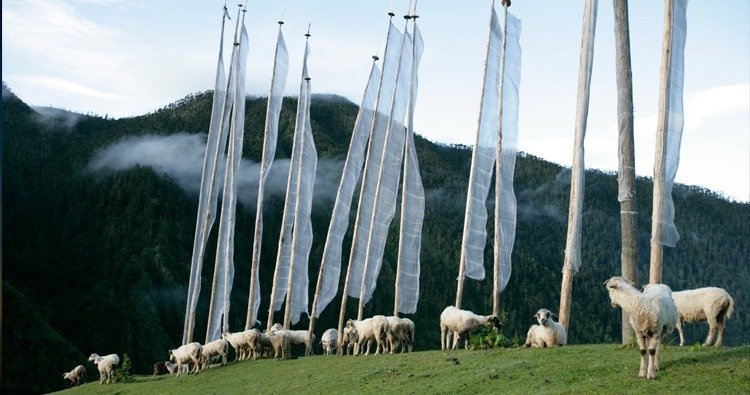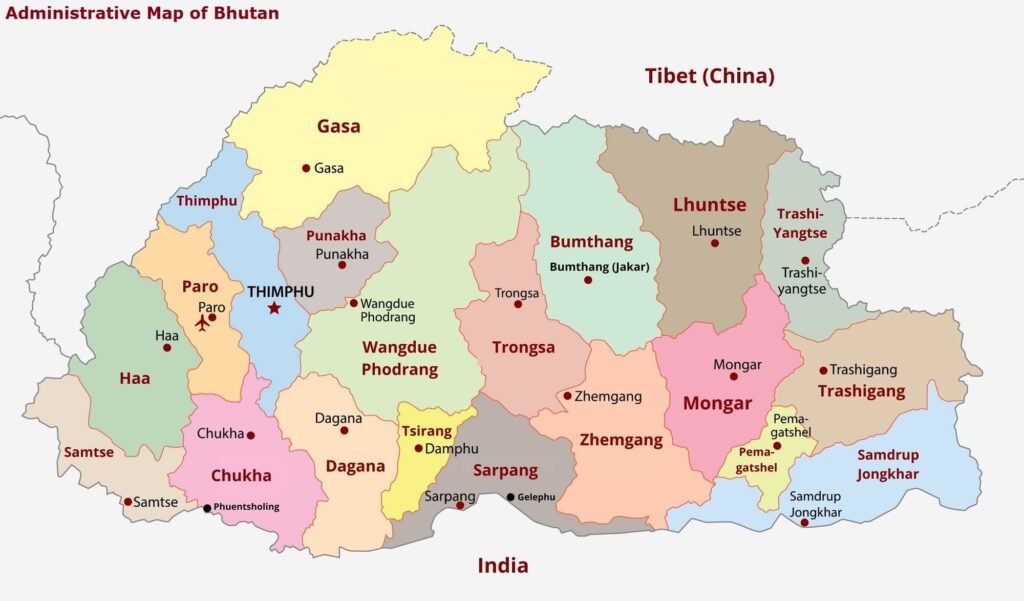
Duration: 25 days
Max. Elevation: 5,320m
Highest Camp: 5,050m
Standard: Hard
Best Seasons: Mid June to Mid October
Start: Drukgyel Dzong (Paro)
Finish: Sephu (Trongsa)
SUMMARY
The Lonely Planet describes this as one of the most difficult treks of the world.
- From Laya it takes you into high altitudes of the Bhutanese Himalayas.
- Spectacular peaks and trek through the most remote areas up to very high altitudes above 5,000m.
- Camps sometimes on blankets of snow. Trekkers are taken into the Lunana region and further on to Gangkhar Puensum and Bumthang or down to Sephu in Trongsa district, depending on the route chosen.
ITINERARY
Day 11: Rejuvenation in Laya
If you have trekked from Drukgyel Dzong you are advised to spend a day recuperating and preparing for the upcoming challenge. Those coming from Tashitang/Damji (Punakha) are also advised to acclimatize at Laya. During the day’s break, one can have a good time relishing the great views from Laya and interacting with its special inhabitants.
Day 12: Laya – Rhoduphu (Distance 19km, six to eight hours, 1,030m ascent, 750m descent, camp altitude 4,160m)
It is a down-hill trek from Laya to an army camp. From there the trekkers move alongside the river till the turn off point to Rhoduphu. After lunch begins the climb through rhododendron bushes till the camp at Roduphu, which is just next to Rhodu Chhu.
Day 13: Rhodophu – Narethang (Distance 17km, five to six hours, 740m ascent, camp altitude 4,900m)
You again continue following the river for about half an hour and then embark on a steady climb to a high and open valley at 4,600m and further to Tsomo La (4,900m). Tsomo La offers a superb view of Lunana, Mount Jomolhari, Jichu Drake, and the Tibetan border. The route then crosses a flat, barren plateau at about 5,000m. The campsite at Narethang is towered by the Gangla Karchung peak.(6,395m).
Day 14: Narethang – Tarina (Distance 18km, five to six hours, 270m ascent, 1,200m descent, camp altitude 3,970m).
The trek continues with an uphill trek for about an hour to Gangla Karchung La (5,120m). The pass offers one of the most stunning views of the entire range of mountains including Jekangphu Gang (7,100m), Tsenda Kang and Teri Gang (7,300m). From the pass one descends along a large moraine and is greeted with extraordinary views such as a massive glacier descending from Teri Kang to a deep turquoise lake at its foot. It is from here that a glacial lake burst in the early 1960s, causing widespread damage and partially destroying Punakha Dzong. The final leg of the trail is a very long descent through thick rhododendron bushes to Tarina valley. There are several good campsites along the Tang Chhu.
Day 15: Tarina – Woche (Distance 17km, six to seven hours, 270m ascent, 330m descent, camp altitude 3,910m)
Following the upper ridges of the Pho Chhu, the trek goes along conifer forests and beautiful waterfalls. It then climbs over a ridge and drops to Woche, a settlement of a few houses, the first village in the Lunana region.
Day 16: Woche-Lhedi (Distance 17km, six to seven hours, 980m ascent, 1,190m descent, camp altitude 3,700m).
The day is a trek through thick forests of juniper, fir and rhododendron bushes. It also involves ascending to Keche La pass (4,650m) where one can have a great view of the surrounding mountains again. Once you cross the pass, the route descends to the riverside. You will be walking through a village offering a stunning view of Table Mountain and others. You then follow the river till Lhedi vlllage, which has a basic health unit, a school and a wireless telephone connection.
Day 17: Lhedi-Thanza (Distance 17km, seven to eight hours, 450m ascent, camp altitude 4,150m)
In clear weather, you will have great views of Table Mountain (7,100m). Around lunchtime you will pass the small village of Chozo (4,090m) which has a dzong still in use. On reaching Thanza again you will have a great view of Table Mountain which forms a 3,000m high wall of snow and ice behind the village. Although there are possibilities to camp directly at Thanza, most groups prefer to camp in Thoencha.
Day 18: Rest day at Thanza
This offers you an opportunity to either interact with the people of Thanza or climb up the ridge for fascinating views of lakes and mountains. However, as new yaks have to be arranged (the yaks from Laya will not go further than Thanza) you might have to spend one day at Thanza anyway.
Day 19: Thanza – Damji
(Distance 8km, three to four hours, 80m ascent, camp altitude 4,230m).
After you reach Thoencha, the trek starts to ascend up till a large boulder, from where one can have a spectacular view of Thanza, Toencha and Choso villages, including the surrounding mountains. Then you can usher in a few hours of relatively flat and easy walking, until you reach a yak meadow with some yak herders’ huts. This is an excellent campsite with a great chance to spot some blue sheep on the hills above. Near the campsite is a trail junction, which will give you the choice between the routes up to Gangkhar Puensum base camp, and further on to Bumthang or to Sephu in Trongsa district.
Day 20: Damji – Tshochena
(Distance 12km, five to six hours, 980m ascent, 240m descent, camp altitude 4,970m).
After having chosen the route to Sephu, the trek will lead you to a creek, which you need to cross. Following a long climb, you will reach Jaze La (5,150m) with spectacular panoramic mountain views. The trail then descends and takes one between snow covered peaks and a couple of small lakes to the campsite near the shore of Tshochena Lake.
Day 21: Tshochena – Jichu Dramo
(Distance 14km, four to five hours, 230m ascent, 150m descent, camp altitude 5,050m).
The trek takes you along the bank of the blue green lake to a ridge at 5,100m. Yet again, you can see a spectacular view in all directions. The route then traverses up and down over small hills, until you reach a glacial lake, after which the route again descends. However, it again ascends till you reach the next pass, the Loju La (5,140m). Towards the final leg of the day’s trek, you cross a small saddle (5,100m) and enter a wide glacial valley from where the trail descends gradually to the campsite at Jichu Dramo.
Day 22: Jichu Dramo – Chukarpo
(Distance 18km, five to six hours, 320m ascent, 730m descent, camp altitude 4,600m).
As soon as you leave the camp, you begin a climb through a moraine to Rinchen Zoe La (5,320m). Your endurance will be rewarded as you see spectacular mountain scenery, including Gangkhar Puensum on this trek route. Towering above the pass in the west is Rinchen Zoe Peak (5,650).
Descending from the pass, the route will lead you into a wide valley with several lakes and steeply down along a moraine to the Thamphe Chhu. From here, the vegetation begins to thicken again and you will see the first real trees since Lhedi. After a couple of hours, you reach the campsite at Chukarpo.
Day 23: Chukarpo – Thampe Tsho
(Distance 18km, five to six hours, 400m ascent, 700m descent, camp altitude 4,300m)
The trek’s descent continues along the river till you reach the yak herder huts at Gala Pang Chhu (4010m). From here the trail climbs steeply towards Thampe Tsho, a beautiful clear turquoise lake, with the campsite next to it.
Day 24: Thampe Tsho – Maurothang
(Distance 14km, five hours, 330m ascent, 1020m descent, camp altitude 3,610m).
Today, you begin with a steep ascend to reach the last pass on your trek trail, Thampe La (4,600m). You could spot some blue sheep on the way. The path then descends to the sacred lake, Om Thso. You will pass a waterfall and reach another lake, a smaller one 100m below to descend steeply to the Nikka Chhu. Finally, the path traverses through mixed forest to a large clearing on the banks of the river with a few yak herders’ huts, at Maurothang.
Day 25: Maurothang – Sephu
(Distance 18km, five to six hours, 990m descent).
This will be the last day of an extraordinary trek and your porters will have to change from yaks to horses as the yaks will not be willing to go further down. You move on a path following the Nikka Chhu to reach a large grassy area overlooking the road and the village of Sephu. Your final destination is the road at the Nikka Chhu bridge at Sephu, where you will find several stores (mainly selling bamboo products) and small restaurants.
